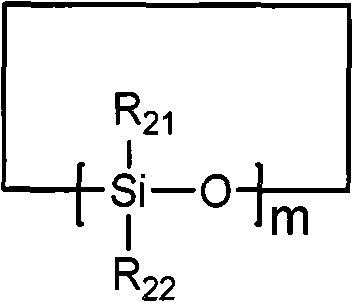Release agent and application thereof
A technology of release agent and emulsifier, which is applied in the direction of additives, base materials, petroleum industry, etc., and can solve the problems of large differences in product gloss and complicated construction
- Summary
- Abstract
- Description
- Claims
- Application Information
AI Technical Summary
Problems solved by technology
Method used
Image
Examples
Embodiment 1
[0099] At room temperature, add the ingredients in Table 1 into the high-speed dispersion tank, and stir at a speed of 1500 rpm for 20 minutes to make them evenly mixed. Then, at 1500 rpm, 31.6 g of deionized water was added dropwise at a constant speed within 30 minutes; after the dripping, continued stirring at 200 rpm for 30 minutes to obtain the final product. The release agent has a solid content of 50%, can be stored at room temperature for 1 month, and can be diluted with water when used. The release agent prepared in Example 1 is sprayed on the metal mold, which can be cured to form a film at 160°C for 10 minutes, and the EPDM rubber is released by using this release agent to obtain a rubber product with a glossiness of 0.7°. It can be demolded more than 20 times in one spraying, and the rubber gloss of each mold is constant. Demoulding thermoplastic polyurethane materials, products with a gloss of 2.7° can be obtained; demoulding polybenzoxazine materials, products w...
Embodiment 2
[0103]At room temperature, add the ingredients in Table 2 into the high-speed dispersion tank, and stir at a speed of 1500 rpm for 20 minutes to make them evenly mixed. Then, at 1500 rpm, 31.6 g of deionized water was added dropwise at a constant speed within 30 minutes; after the dripping, continued stirring at 200 rpm for 30 minutes to obtain the final product. The release agent has a solid content of 55%, can be stored at room temperature for 2 months, and can be diluted with water when used. The release agent prepared in Example 2 is sprayed on the metal mold, and it can be cured to form a film at 160 ° C for 10 minutes. Using this release agent to release the EPDM rubber, a rubber product with a gloss of 1.0° can be obtained. It can be demolded more than 20 times in one spraying, and the rubber gloss of each mold is constant.
[0104] Table 2
[0105]
[0106]
Embodiment 3
[0108] At room temperature, add the ingredients in Table 3 into the high-speed dispersion tank, and stir at a speed of 1500 rpm for 20 minutes to make them evenly mixed. Then, at 1500 rpm, add 30.4 g of deionized water dropwise at a constant speed within 30 minutes; after the dripping, continue stirring at 200 rpm for 30 minutes to obtain the final product. The release agent has a solid content of 50%, can be stored at room temperature for 1 month, and can be diluted with water when used. The release agent prepared in Example 3 is sprayed on the metal mold, which can be cured to form a film at 160° C. for 10 minutes. The release agent is used to release the EPDM rubber to obtain a rubber product with a glossiness of 2.7°. It can be demolded more than 20 times in one spraying, and the rubber gloss of each mold is constant.
[0109] table 3
[0110]
PUM
| Property | Measurement | Unit |
|---|---|---|
| Gloss | aaaaa | aaaaa |
| Gloss | aaaaa | aaaaa |
| Gloss | aaaaa | aaaaa |
Abstract
Description
Claims
Application Information
 Login to View More
Login to View More - R&D Engineer
- R&D Manager
- IP Professional
- Industry Leading Data Capabilities
- Powerful AI technology
- Patent DNA Extraction
Browse by: Latest US Patents, China's latest patents, Technical Efficacy Thesaurus, Application Domain, Technology Topic, Popular Technical Reports.
© 2024 PatSnap. All rights reserved.Legal|Privacy policy|Modern Slavery Act Transparency Statement|Sitemap|About US| Contact US: help@patsnap.com










